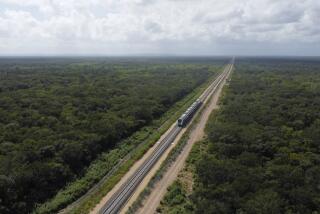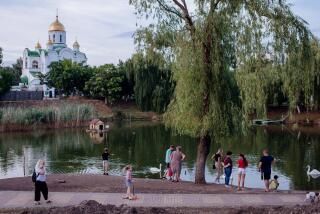Russia’s Railway to Riches Is Stalled
- Share via
SEVEROBAIKALSK, Russia — In the frozen Siberian wilderness, there lies an untapped territory so abundant in natural resources that Russian officials proclaim it the richest region on Earth. Someday, they say, a monumental rail line--a second Trans-Siberian Railway--will haul minerals and timber from this hinterland and make Russia wealthy.
The dream of exploiting this fortune dates back to the czars. Communist rulers embraced the idea, and 60 years ago, Josef Stalin sent prisoners to cut through the nearly impenetrable mountains and begin building the Baikal-Amur Railway.
Now, long after the railroad’s original designers have died, the forests, ore and coal would appear to be within reach. At an estimated cost of $10 billion, the Baikal-Amur Railway is nearly complete, and its last tunnel could be finished by the end of the decade. Using temporary bypasses around construction zones, the railroad has been moving some cargo with little fanfare since 1989.
“The economic future of Russia is inseparable from the Baikal-Amur Railway,” declared Leonty G. Makhitarov, deputy general director of Moscow-based Baminvest, which manages the rail line. “These reserves are measured in billions of tons. As soon as industry demands the natural resources, we can expect a real boom, an industrial explosion.”
But the economic stagnation gripping the country has postponed fulfillment of the ambitious development plan its boosters say is the key to Russia’s prosperity. The huge factories designed to smelt the ore and mill the lumber exist only on paper, and the government does not have the money to build them.
Instead of great wealth, the railway’s biggest product is the Balki--the Siberian slum here on the north end of Lake Baikal where thousands of former railroad workers and their families live in poverty. Once, they worked for the glory of the Soviet Union to carve the rail line through Siberia’s icy mountains and virgin taiga forest. But the same market forces that created Russia’s new millionaires abandoned these loyal proletarians by the side of the tracks.
“I helped create the Baikal-Amur Railway, and at the end of my life I’m left with nothing at all,” said Yevgeny A. Tretyakov, 63, a retired railroad worker who lives with his wife in a dilapidated one-room trailer without running water. “I am very much ashamed for my country. It is the eve of the 21st century, and we have to live in such appalling conditions.”
This is a region where perestroika--economic restructuring--is a dirty word and where Communist idealism remains strong. Residents of the Balki long for the days of the Soviet Union, when even doddering President Leonid I. Brezhnev could guarantee every worker a salary.
Hard Times
Galina Kuznetsova lives in the Balki with her daughter and granddaughter in a two-room shack she has called home for 16 years. They share a street-corner outhouse with dozens of neighbors, even in the subzero Siberian winter. She lives on Workers Street but has no job--and little chance of finding one.
“I would love to live under Brezhnev again,” the 40-year-old unemployed railroad worker said bitterly. “With Brezhnev, I knew I had a job and a piece of bread. Now, I don’t even have money for a crust of bread.”
The Baikal-Amur Railway is everything this slum is not: modern, clean--and empty. Its single track and power poles seem to stretch forever through the taiga. But at any given point on the line, one can wait much of the day to see a train. Officials optimistically say the railway is running at 30% to 50% of capacity, but they acknowledge that only six trains operate each day along the entire 2,000-mile system.
Commonly known by its Russian acronym, BAM, the rail line is a feat of Soviet engineering. It cuts through five mountain ranges, spans 17 rivers and crosses vast stretches of permafrost, taming the wilds of Siberia where winter lasts nine months and temperatures drop to 50 below.
*
During the 1930s, Stalin mobilized half a million prisoners to construct the line. Whether a completion date was set is murky--since this was a project of the gulag, it was done more or less secretly. In any event, the project came to a halt with the onset of World War II. When relations with China soured in the 1960s, Russia feared that its former ally would try to seize part of the vital Trans-Siberian Railway, which runs perilously close to the Chinese border. To create an alternate route, Brezhnev in 1974 resumed construction of BAM, which was protected by mountains, making it a national priority.
The brightest and strongest of the new Soviet generation were recruited to work on the project and sent to live in Severobaikalsk and in settlements that sprang up along the line.
“This was viewed as one of the vital tasks, and the best people were selected to go there,” recalled Makhitarov, who previously worked in Siberia as BAM’s chief engineer. “These were the young people, the talented, the energetic. Although they lived in temporary huts, they were supplied with better foods and consumer goods than any part of the country.”
BAM’s Advantages
The Trans-Siberian Railway, itself a monumental undertaking, linked Russia’s distant regions for the first time when it was completed in 1905, extending 5,776 miles from Moscow to Vladivostok. BAM runs roughly parallel to the Trans-Siberian line, but about 250 miles to the north. It passes around the upper end of Lake Baikal--the largest freshwater lake in Eurasia--and connects with the older route in Taishet to the west and Komsomolsk-on-Amur in the east.
Between these cities, BAM has the advantage of being 300 miles shorter and has siphoned off some of the Trans-Siberian’s cargo traffic. BAM will become an even better option once work is completed on its last tunnel, a 10-mile shaft beset by numerous engineering challenges.
Crews working deep underground are within 75 yards of breaking through to each other from the opposite sides of the tunnel, but they must cope with such problems as unstable soil, large quantities of water, and radon gas at levels 100 times greater than are considered safe.
*
Sergei Korolko, chief engineer of Bamtonnelstroi, the company building the tunnel, said the project is at least two years from completion--once money is found to finance the work. For now, trains must take a steep, winding 35-mile mountain bypass that adds significantly to the time and expense of using BAM.
“When the tunnel is complete, the capacity of the railroad will increase tremendously,” Korolko said.
Railway designers planned 10 major industrial centers along the Baikal-Amur corridor to process its timber, coal, gold, silver, copper, jade, lead, zinc, iron, titanium, cadmium, vanadium, magnesium and other resources. But so far, only a coal mine has opened; instead of powering new industry in the region, its high-quality coal is being shipped to Japan for use in making steel.
For now, the money-losing railway has no capital to invest in developing the industry that could ultimately ensure its success. Officials say it has been unable to lure outside investment because of its remote location, the extreme climate, the high cost of electricity--and the high price BAM charges for hauling cargo.
“So far, these have scared off the investors,” Makhitarov said. “Railroad tariffs are so high that some industries don’t think it’s profitable to transport their products around the country. We must wait until the economy of the country stabilizes.”
‘We Live Like Pigs’
Nevertheless, some BAM administrators say the railroad could begin making a small profit as early as next year by continuing to cut costs, lay off workers and shed responsibility for housing its former employees. Restructuring like a capitalist company, the railway has already spun off some of its unsuccessful divisions and gotten rid of thousands of laborers.
Because of its natural beauty, Lake Baikal is often called “the pearl of Siberia.” But in Severobaikalsk, just a mile from its northern shore, thousands of unemployed railroad workers live in the Balki in what was supposed to be temporary housing.
Huts and shacks are patched together with scraps of wood, cardboard and plastic. A few residents raise goats--which outnumber cars on the dirt roads. On every block stands a communal outhouse, and during the long winter the city delivers water twice a week.
“You can’t really call this a life,” said Kuznetsova, standing on her front stoop, arms folded across her thin frame. “It’s survival. We live like pigs. What can be done? Nothing. I will end my life in this filthy shed.”
To heat her house in winter, she uses a 3-foot-long metal rod plugged into a wall socket and inserted into a pipe full of water--the kind of device responsible for burning down a number of houses in the slum.
“BAM was very good at the beginning, and it was very good here, but now we have been brought down to our knees,” she said. “It’s only the Russian people who are capable of taking this punishment for so long.”
Tretyakov, the retired BAM worker, has spent 17 years living in the tired green trailer that measures only 110 square feet. He dreams of visiting his relatives in western Russia, but a one-way ticket costs twice as much as his $63 monthly pension.
“That’s the preposterous thing,” he said. “We devote all our lives to the railroad and making transportation better, and now we can’t even afford to go see our relatives.”
While the Balki is the largest of the railway slums, former BAM workers also struggle to survive in small settlements scattered along the line.
Twenty-five miles up a jolting dirt road from Severobaikalsk, the railroad village of Solnechny looks as if it were the scene of a battle.
All around the village, burned-out buildings and piles of debris mark the sites of what used to be apartments.
By day, railroad authorities have knocked down empty dwellings and hauled away usable timber. By night, an arsonist has set fire to more than half a dozen communal buildings, hastening abandonment of the village.
Not long ago, it was a thriving settlement of 2,000 people set in a beautiful valley surrounded by snowy peaks. But work on this section of the railroad is finished, and only 200 residents remain--the ones who have no money and no place to go.
*
“This is a ghost town, and the people who live here are ghosts,” said Valentina Azaudbayeva, Solnechny’s nurse, who took over an empty apartment after hers was destroyed in a fire.
“We have lived with BAM for 17 years, and now we are completely poor.”
(BEGIN TEXT OF INFOBOX / INFOGRAPHIC)
Second Major Rail Line
Russia’s long-delayed Baikal-Amur Railway is nearing completion, more than half a century after construction began.
More to Read
Sign up for Essential California
The most important California stories and recommendations in your inbox every morning.
You may occasionally receive promotional content from the Los Angeles Times.










